Seven Impossible Interviews Before Breakfast #65: Author/Illustrator Eric Rohmann
 February 12th, 2008 by jules
February 12th, 2008 by jules
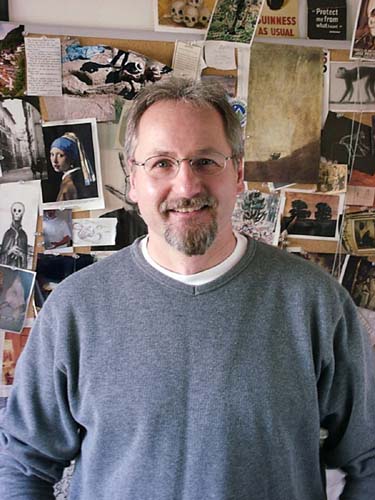 7-Imp is particularly excited to be chatting today with author/illustrator Eric Rohmann, who — in the words of Publishers Weekly — “has perfected the art of letting the pictures tell the story.” In this author spotlight at Random House, Eric writes, “I wasn’t a very good student. I remember my high school guidance counselor suggested I consider a trade: ‘Perhaps ship-fitting or something in a lumber yard?'” Well, we’re glad he chose illustration over a lumber yard after all, because he has brought the world of children’s literature some beautiful, unforgettable picture books and “magnificent oil paintings {which} masterfully mix reality and fantasy” (Los Angeles Times).
7-Imp is particularly excited to be chatting today with author/illustrator Eric Rohmann, who — in the words of Publishers Weekly — “has perfected the art of letting the pictures tell the story.” In this author spotlight at Random House, Eric writes, “I wasn’t a very good student. I remember my high school guidance counselor suggested I consider a trade: ‘Perhaps ship-fitting or something in a lumber yard?'” Well, we’re glad he chose illustration over a lumber yard after all, because he has brought the world of children’s literature some beautiful, unforgettable picture books and “magnificent oil paintings {which} masterfully mix reality and fantasy” (Los Angeles Times).
 Eric — or, Theophrastus von Sparkenpumpe, if you’re Philip Pullman — made his children’s book debut in 1994 with Time Flies (Crown), a surreal, wordless tale of one bird’s journey back to the time of living dinosaurs (“the scientifically minded will be wowed by Rohmann’s oil paintings, which capture the textures of bone, tooth, eyeball, etc., with as much attentiveness and morbidity as, say, an 18th-century still life of gamebirds,” wrote Publishers Weekly). Time Flies was awarded a Caldecott Honor in ’95. In 2002, My Friend Rabbit (Roaring Brook Press), brought Eric a Caldecott Medal. This story of friendship — a “dramatic visual romp,” in the words of Pat Scales, chair of the 2003 Caldecott Award committee — was rendered in bright, hand-colored relief prints. In this Q & A with SCBWI in Southern California, Eric explained,
Eric — or, Theophrastus von Sparkenpumpe, if you’re Philip Pullman — made his children’s book debut in 1994 with Time Flies (Crown), a surreal, wordless tale of one bird’s journey back to the time of living dinosaurs (“the scientifically minded will be wowed by Rohmann’s oil paintings, which capture the textures of bone, tooth, eyeball, etc., with as much attentiveness and morbidity as, say, an 18th-century still life of gamebirds,” wrote Publishers Weekly). Time Flies was awarded a Caldecott Honor in ’95. In 2002, My Friend Rabbit (Roaring Brook Press), brought Eric a Caldecott Medal. This story of friendship — a “dramatic visual romp,” in the words of Pat Scales, chair of the 2003 Caldecott Award committee — was rendered in bright, hand-colored relief prints. In this Q & A with SCBWI in Southern California, Eric explained,
My Friend Rabbit would not have worked using the more elaborate, naturalistic oil paintings of my other books. With Rabbit, I needed the change to stay interested. A few years ago I made a painting for a book jacket and when I had finished I hardly recalled making the painting. I had become so facile, so practiced at my way of painting that I had stopped inventing and began to copy myself. I answered every question with an answer I had used before. I felt I needed to try something different, to shock my system. It’s what Ray Bradbury once called, ‘Jumping off a cliff and making wings on the way down.’
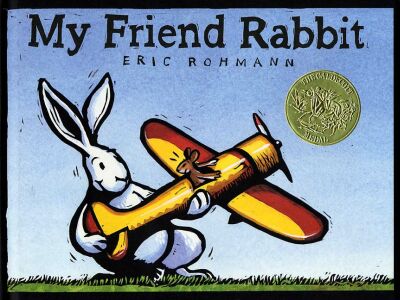 In the years between Time Flies and My Friend Rabbit, Eric brought his fans King Crow, written by Jennifer Armstrong (Crown, 1995), the story of a king jailed by an evil foe who receives invaluable help from a crow; The Cinder-Eyed Cats (Crown, 1997), what School Library Journal called a “bedtime piece with flair”; and The Prairie Train by Antoine Ó Flatharta (Crown, 1999), the story of a young Irish immigrant boy, who travels by steam-engine across the American prairie to a new life with memories of the old country pulling at his heart. Pumpkinhead (Alfred A. Knopf, 2003) and Clara and Asha (Roaring Brook Press, 2005), the latter named a 2006 ALA Notable Children’s Book, followed My Friend Rabbit. In their review of Clara and Asha, School Library Journal praised Rohmann’s “characteristically spare story line and larger-than-life visuals.”
In the years between Time Flies and My Friend Rabbit, Eric brought his fans King Crow, written by Jennifer Armstrong (Crown, 1995), the story of a king jailed by an evil foe who receives invaluable help from a crow; The Cinder-Eyed Cats (Crown, 1997), what School Library Journal called a “bedtime piece with flair”; and The Prairie Train by Antoine Ó Flatharta (Crown, 1999), the story of a young Irish immigrant boy, who travels by steam-engine across the American prairie to a new life with memories of the old country pulling at his heart. Pumpkinhead (Alfred A. Knopf, 2003) and Clara and Asha (Roaring Brook Press, 2005), the latter named a 2006 ALA Notable Children’s Book, followed My Friend Rabbit. In their review of Clara and Asha, School Library Journal praised Rohmann’s “characteristically spare story line and larger-than-life visuals.”
 Philip Pullman, in his memorable tribute to Rohmann after he won the Caldecott for My Friend Rabbit and whose cover for The Golden Compass was painted by Rohmann, said:
Philip Pullman, in his memorable tribute to Rohmann after he won the Caldecott for My Friend Rabbit and whose cover for The Golden Compass was painted by Rohmann, said:
“{W}hat stood out at once for me was the draftsmanship. Anyone who can get a dog to look like a dog, a crow to look like a crow, or a hand to look properly articulated with an arm that in turn fits onto a shoulder that in turn looks as if it has a proper structural relationship with a backbone — is someone who deserves respect . . . When you look at a page of Mr. Rohmann’s work, you see not only the expression of a great innate talent but also the consequence of solid work and study and thought. I mean toil, the daily engagement with the tools, the never-ending struggle to make two dimensions represent three, the fresh-every-day effort to persuade the color to flow where you want it to and to preserve its warmth and brilliance all the way through the printing process.”
Wow. What he said. He captures well the charm of Rohmann’s work, no?
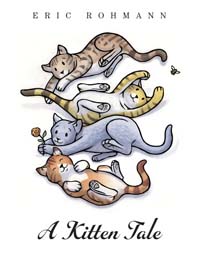 Eric’s newest title, A Kitten Tale, which I reviewed here with much enthusiasm and manic energy (’cause it’s that good), was released this January. It has garnered starred reviews in Publishers Weekly, School Library Journal, and Kirkus Reviews, SLJ describing it as a “playful look at living life to the fullest” and “a natural for young children.” Eric shared some art work from the book with us for a previous Sunday feature, which we’ll share again in this interview (I hope the colors on these illustrations are right; they look slightly different than the ones in the ARC I have, but it could be an artifact of my computer).
Eric’s newest title, A Kitten Tale, which I reviewed here with much enthusiasm and manic energy (’cause it’s that good), was released this January. It has garnered starred reviews in Publishers Weekly, School Library Journal, and Kirkus Reviews, SLJ describing it as a “playful look at living life to the fullest” and “a natural for young children.” Eric shared some art work from the book with us for a previous Sunday feature, which we’ll share again in this interview (I hope the colors on these illustrations are right; they look slightly different than the ones in the ARC I have, but it could be an artifact of my computer).
Perhaps the primary appeal of Eric’s work is this, captured in the last response he gave in this short 2005 BookPage interview, the message he would like to send to children: “Look closely. Tell stories. Play. Make mistakes. Learn. Carry on.” Let us carry on with the interview then, and thanks to Eric for stopping by for seven impossible things before breakfast — rather, six (“I can only come up with six…but give me some time!” he told us).
7-Imp: A Kitten Tale is simply splendorous. Please tell us a bit about what made you want to write that particular story, how it came about, etc.
Eric: Thanks for the kind words about the kittens. Always wonderful to hear.
All of my books start with a little idea and then build into larger stories as I work. I suppose this is the way all writers and artist work: general to specific. Start with a small thing, have at it and see what happens. A Kitten Tale began as a few sketches and the vague notion of writing about a reluctant kitten (a characteristic of kittens and why the book is not A Baboon Tale instead). Somewhere in the corners of my mind I had a notion that the kitten would eventually finds his way to curiosity. There is some of that in the finished book, but it certainly changed, clarified and simplified over time.

7-Imp: In reading about you online, I stumbled across this quote attributed to you, which I remember reading in grad school and falling in love with:
Children are the best audience: they are curious, enthusiastic, impulsive, generous, and pleased by simple joys. They laugh easily at the ridiculous and are willing to believe the absurd. Children are not ironic, disillusioned, or indifferent, but hopeful, open-minded, and openhearted, with a voracious hunger for pictures and stories.
Your bio says you taught drawing and printmaking for a while. For how long in your career as a visual artist did you work with adults before deciding to turn your attention toward a child audience?
Eric: As a student, I thought I would follow the path of many of my friends: graduate and teach. We all figured this would give us plenty of studio time as well as a steady income (practical, and a bit hopeful). I did not find a permanent teaching position so I took a job at a summer arts program called Belvoir Terrace in Massachusetts where I taught art to girls ages 7 to 17. My pictures have always been narrative — each image like a still image from a longer film — so when I began teaching art to kids, I found my audience. Kids and pictures that tell stories are a natural fit.
7-Imp: On the question of audience, it seems that my very favorite children’s book illustrators, when asked who they have in mind when creating books, respond that they are making the books for themselves and not creating it with children specifically in mind. You have said the same (“I make books for myself — it’s the audience I understand most — and I’m blessed that children seem to like what I do”). Has that always been the case, or is that something you grew into as an illustrator as your work has evolved?

Eric: Yes it has evolved. I wrote that statement early on, and as I’ve made more books, read more books, and spoken to more kids, I have a better sense of what they look at, what they are curious about, what makes them laugh and think. I certainly can’t think like a six-year-old (although I was one once and have the photos to prove it), but I’m always thinking of them as I work.
 7-Imp: What exactly is your process when you are illustrating a book, particularly when it’s one you have written (as most of yours have been)? You can start wherever you’d like when answering: getting the idea, starting to write/illustrate, or even what it’s like under deadline, etc. Do you outline or sketch a great deal of the book before you write/illustrate or just let your muse lead you on and see where you end up?
7-Imp: What exactly is your process when you are illustrating a book, particularly when it’s one you have written (as most of yours have been)? You can start wherever you’d like when answering: getting the idea, starting to write/illustrate, or even what it’s like under deadline, etc. Do you outline or sketch a great deal of the book before you write/illustrate or just let your muse lead you on and see where you end up?
My Friend Rabbit began as a doodle of a rabbit holding a giant paper airplane. A Kitten Tale was only a snip of story about a reluctant kitten. From there I made a drawing, looked at some photos, wrote a bit, made another sketch, researched, wrote, drew, and wrote more . . . you get it. The process is a bit chaotic, but it is the only way I can find my way. I must put something on paper, look at it carefully, before I know where to go next.
The muse — what drives me forward — is the desire to tell a story. I think in narratives. I draw all the time. Together these become picturebooks. The process is simple trial and error, which includes many drafts and many sketches, storyboards and dummies. I keep working on something until it makes sense — both story and images.
7-Imp: How does your work as a printmaker and fine bookmaker affect your illustration, if at all?
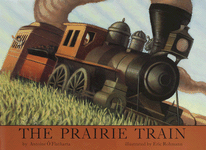 Eric: The more techniques and methods you practice, the more extensive your toolbox. Different stories call for different kinds of pictures. Printmaking is important to my work, because it gives my images a different look. What I mean is that as I translate a pencil drawing into a woodcut, the line quality changes. Therefore, the feel of the images changes. This allows the books to look different from the painted images.
Eric: The more techniques and methods you practice, the more extensive your toolbox. Different stories call for different kinds of pictures. Printmaking is important to my work, because it gives my images a different look. What I mean is that as I translate a pencil drawing into a woodcut, the line quality changes. Therefore, the feel of the images changes. This allows the books to look different from the painted images.
Having made books by hand helps me understand the book form. The cover, the end papers, page turns, the gutter, the heft and shape of the book.
7-Imp: I read the following from you online: “I don’t think I create paintings as much as recognize them when I bump into them.” I love that, and it makes me think of how a lot of authors tend to talk about characters they have created and stories they have written, that the characters found them and begged to be written, etc. Can you elaborate a bit on that statement you made, just because – as an art lover but not an artist myself — I think it’s intriguing.
Eric: I’ve never had a character speak to me — jeez, I wish they would and do some of the work — but what I meant is that I’m never quite sure of what I’m after until I see it there on the paper in front of me. I’m not so much a creator as a discoverer.
 7-Imp: Can you tell us a bit about what it meant to you, at the beginning of your career in children’s books, to have received such validation for your work (if that’s how you perceived it, that is), a Caldecott Honor for Time Flies — especially since, as you stated in an online interview, it had been rejected many times by various publishers before finding a home at Crown?
7-Imp: Can you tell us a bit about what it meant to you, at the beginning of your career in children’s books, to have received such validation for your work (if that’s how you perceived it, that is), a Caldecott Honor for Time Flies — especially since, as you stated in an online interview, it had been rejected many times by various publishers before finding a home at Crown?
Eric: A number of breakthroughs occurred at the time. I managed to make a dummy — the visual story — that as clear and complete. I was published after many rejections. But the thing I’m most proud of is that after Crown agreed to make Time Flies, I had five months and made the eighteen paintings — which was about as many paintings as I’d made up to that point in my life. That accomplishment feels like the most significant validation.
I was, of course, aware of Caldecott, but didn’t know how the award was given or when, so when I received the Honor I had little clue of what it meant. Suddenly people knew the book. Which meant kids got to see it. In the end, that is the happily ever after.
7-Imp: In a previous interview, you talked about you strayed from the medium of oil and used relief prints for My Friend Rabbit, how you try to use the technique that works best with the story you’ve created in lieu of a more easily-marketed signature style. Can you talk a little bit more about that?
Eric: It works two ways for me. I get to try new things, keep it fresh, and I am not limited to the kinds of books one “style” would allow.
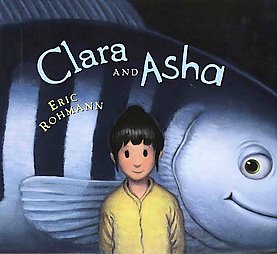 7-Imp: The School Library Journal review for Clara and Asha noted what they called your “signature panoramic perspectives.” What do you love about that perspective that takes our breath away, as readers, in your gorgeous paintings?
7-Imp: The School Library Journal review for Clara and Asha noted what they called your “signature panoramic perspectives.” What do you love about that perspective that takes our breath away, as readers, in your gorgeous paintings?
Eric: I’m a child of the movies. Notice how the open picture book is often the proportion of the movie screen. I was influenced by Robert McCloskey, Wanda Gag, Sendak and Van Allsburg, but also by David Lean, Steven Speilberg and John Ford. Look at the starry night in Sylvester and the Magic Pebble and you’ll see the power of the two page image.
7-Imp: You’ve said in interviews that you volunteered at a zoo in high school, studied biology afterwards, and loved (and still love) to visit museums. Do you attribute your ability to make “a dog look like a dog” and “a hand to look properly articulated with an arm” (in Pullman’s words) to those endeavors? Also, is that a piece of advice, by chance, that you’d give any beginning illustrators who might be reading this -– to remember the toil, the “daily engagement with the tools,” even when the studio might be the last place you want to be?
Eric: Needless to say I’m humbled by his praise. As he might tell you, an artist gets better by making art. So when you start out you look at cats or fish, draw them, get to know them, how they move and what they do. Immerse yourself. Be aware. Look closely.

7-Imp: Did you find it more or less freeing to illustrate another person’s text (with the Jennifer Armstrong and Antoine O´ Flatharta titles), compared to the books you’ve authored and illustrated yourself?
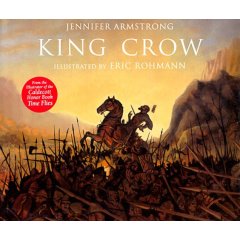 Eric: For me, it’s harder to make pictures for another person’s story. I admire illustrators who do it well, because I have not. For me, there is a tacit lack of freedom that I’ve never been able to fully understand or deal with. Then again, I’m willing to give it a go. In fact, I’m illustrating a playful, action-packed book by Candy Fleming, called Oh, No! Some great stories you just can’t pass up.
Eric: For me, it’s harder to make pictures for another person’s story. I admire illustrators who do it well, because I have not. For me, there is a tacit lack of freedom that I’ve never been able to fully understand or deal with. Then again, I’m willing to give it a go. In fact, I’m illustrating a playful, action-packed book by Candy Fleming, called Oh, No! Some great stories you just can’t pass up.
7-Imp: What do you think draws you to the spare -– or absence of any — text in many of your books?
Eric: My stories begin with lots and lots of words. Then you rewrite, paring the story down to something interesting and clear. Pictures are a different language that also tells stories. Often pictures tell the story, and the words fall away. Pictures and words do different things and I try to use them for what they do best.
7-Imp: Can you tell me about any new titles/projects you might be working on now?
Eric: I already mentioned, Oh, No! with Candy, and I’m also working on a book called The Bone Dog with Roaring Brook Press. Now if I could only figure out how to make the books work . . .
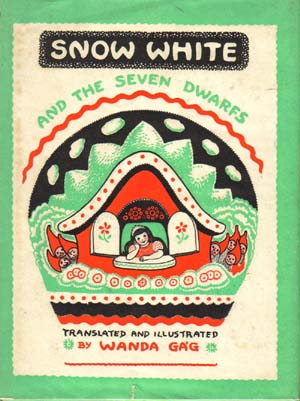 7-Imp: What books or authors and/or illustrators influenced you as an early reader?
7-Imp: What books or authors and/or illustrators influenced you as an early reader?
Eric: I wasn’t a great reader as a kid . . . my intro to books was comics. From there I moved to fantasy and sci fi, and then on to other books. Influences? Helen Sewell, Robert McCloskey, Ruth Krauss, Marcia Brown, Walt Disney, George Herriman, Charles Schultz, Maurice Sendak, William Steig, Wanda Gág, Virginia Lee Burton, William Pène Dubois, the Provensens, Robert Lawson, Marie Hall Ets . . . got another three pages?
7-Imp: What’s one thing that most people don’t know about you?
Eric: I keep a sketchbook/journal with drawings, collage, notions, impressions, complaints, bits of found paper, other artifacts and ephemera. It’s my way of always staying engaged in the world.
7-Imp: If you could have three (living) illustrators or author/illustrators — whom you have not yet met — over for coffee or a glass of rich, red wine, whom would you choose?
Eric: Lisbeth Zwerger, Maurice Sendak, Bill Watterson . . . hmmm? What makes the question so hard is that I have been lucky enough to have met many of my favorites.

7-Imp: What is your favorite word?
Eric: Today it is “Oodaaq” (I just read an article that mentioned this tiny bit of gravel in the Arctic Cicrle thought to be the smallest island on earth). I’ll undoubtedly change my mind when I hear the next good word.
7-Imp: What is your least favorite word?
Eric: Today it’s “overdue” . . . how did I neglect to return those books for so long?
7-Imp: What turns you on creatively, spiritually or emotionally?
Eric: Drawing, traveling, lively evenings with friends, and being surprised by the world.
7-Imp: What turns you off?
Eric: Insincerity in work and in life.
7-Imp: What is your favorite curse word? (optional)
Eric: I can’t choose just one — the great thing about cursing is that they arrive on their own power when most needed.
7-Imp: What sound or noise do you love?
Eric: A fire crackling under a starry sky. The ruffle of leaves in the wind. Lennon and McCartney harmonizing.
7-Imp: What sound or noise do you hate?
Eric: My own voice when I’m cross or moody (others hate it too!).
7-Imp: What profession other than your own would you like to attempt?
Eric: Architect or research librarian.
7-Imp: What profession would you not like to do?
Eric: Accountant (How do they do it? Bless them, so I don’t have to).
7-Imp: If Heaven exists, what would you like to hear God say when you arrive at the Pearly Gates?
Eric: “You’re early. Turn around and try again.”
For more online information about Eric:
- Write-up by Dan Craft for “The Illustrious Art of Eric Rohmann” at The McLean County Arts Center; 2006.
- “Celebrated Author-Illustrator Eric Rohmann Visits Lower School”; LATIN Today; May 14, 2006.
- “Meet Eric Rohmann”; BookPage; 2005.
- Webcast of Eric at Bookfest ’03 (National Book Festival 2003); October 4, 2003.
- Philip Pullman’s tribute to Rohmann; The Horn Book; July/August 2003.
- Eric’s Random House profile; Undated.
- “My Friend Eric Rohmann: Q&A with the 2003 Caldecott Medal Winner for Illustration” by Vicki Arkoff and Stephanie Gwyn Brown; SCBWI Kite Tales (Tri-Regions of Southern California); Undated.
- Bio at Children’s Literature Network; Undated.

What a delightful interview! I’ve been a huge fan of Eric for years–his range continues to amaze me. Even better, Eric is a genuinely nice guy. We were on the same program a few years ago in Connecticut and signed side by side. Eric and I are about the same age and found much to talk about. I want to keep a commonplace book, too (the sketch/book thing he mentioned) and be at his dinner to meet Bill Watterson. Thanks, Jules!
Thank you so much for this wonderful interview! I LOVE those kittens (as you know), and am blown away by Eric’s range of styles and tremendous talent.
Hooray for being “surprised by the world” and for wanting to meet Bill Watterson. (And for oodaaq, a word new to me.)
If being possessed by an overwhelming urge to own everything Eric Rohmann has ever created is the sign of a great interview, then I’d say you’ve done it. Wow. The Golden Compass cover AND those amazing kittens? And he stole my heart with that quote about children being the best audience.
Wow, Eric Rohmann is quickly becoming my favorite illustrator. Thanks for the in depth interview. I look forward to more in the future!
[…] Friend Rabbit”, and the just-released “A Kitten Tale” is interviewed today at Seven Impossible Things Before Breakfast. If you haven’t already done so, click the logo below to head on […]
Wow! Excellent interview.
I had a chance to sit down for a brief interview with Eric several months ago, and that interview will appear at http://www.theedgeoftheforest.com next month, but this interview was so detailed. It really showed Eric’s fantastic personality and wonderful insight.
Eric is a brilliant author/illustrator, and an even better human being. Thanks for letting it all shine through in one great interview!
P.S. I’m so excited about his collaboration with Candy Fleming! I can’t wait to see OH NO!
I met Eric last summer, and he almost bursts with enthusiasm for children’s books. It’s contagious. Fun interview!
Phenomenal. And boy do I love the kittens in that book – I keep forgetting to post a review!
Great interview!
Although, knowing that Rohmann did the cover for the Golden Compass makes all the new editions with the movie tie-in covers all the more tragic.
Rohmann’s on my list of must-buy-as-soon-as-I-hear-about-the-new-book authors. I saw him give his Caldecott speech at the first Newbery/Caldecott banquet I attended, and I’ve been a fan ever since.
(Minh, Those movie tie-in covers have been KILLING me, although I very begrudgingly got a few for my library. I don’t feel good about it, though.)
Jules,
This interview was wonderful. I enjoyed reading about Eric Rohmann’s artsitic process. I love the illsutrations in his new book, A Kitten Tale–the colors, the compositions. I can see where the artistic style he used in Time Flies would not have been as effective for a book like this.
[…] Eric Rohmann (interviewed February 12), pictured here: “My pictures have always been narrative — each image like a still […]
Eric,
Thank you for bringing My Friend Rabbit to this world.
It is one great piece of work!
[…] I’m featuring illustrations from the tiny, square, and perfect Last Song, illustrated by Eric Rohmann (Roaring Brook, September 2010). This is a picture book adaptation of Scottish poet James […]
[…] here’s the best part –- a sort of perfect symmetry if you will. On my last birthday, Eric (Rohmann) handed me an ordinary-shaped box wrapped in bright paper. What’s this? I wondered. A skirt? […]
[…] Author’s Image: From 7 Impossible thing […]
[…] time, I discuss Lois Lowry’s new children’s novel, Bless This Mouse, illustrated by Eric Rohmann. And I’ve got a question for readers, so head on over and join in the discussion, if […]
[…] Fleming, she noted that in Fall 2012 she’ll have a new picture book out, illustrated by Eric Rohmann, called Oh, No! (published by Schwartz & Wade). Below is a sneak peek at this book — a […]
[…] “highly talented mentors” they mention are only the crazy talented Floyd Cooper, Eric Rohmann (both Floyd and Eric are pictured at the top of this post), Kelly Murphy, and Ruth Sanderson. […]
[…] be showcasing Matthew Cordell’s hello! hello! later, as well as Candace Fleming’s and Eric Rohmann’s Oh, No! And, if you want to see more from Philip and Erin Stead’s Bear Has a Story to Tell, I […]
[…] I was sitting in a corner of the library, either studying or reading a magazine. I glanced up, and Eric Rohmann’s Cinder-Eyed Cats was staring at me from the other side of the room. I looked back down, but I […]
[…] also art in this post from Matt Myers, Erin Stead, Liniers, Eric Rohmann, and […]
[…] week, I wrote here about Candace Fleming’s Giant Squid, illustrated by Eric Rohmann (Neal Porter/Roaring Brook, September 2016); Elise Gravel’s The Great Antonio (TOON Books, […]
[…] Bookshop in Naperville, Illinois …Pictured L to R: Chris Sheban, Tom Lichtenheld, Eric Rohmann, Matt,Henkes (seated), Stacy Curtis, and Larry Day(Click to […]